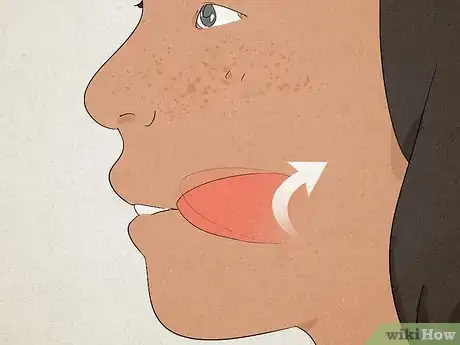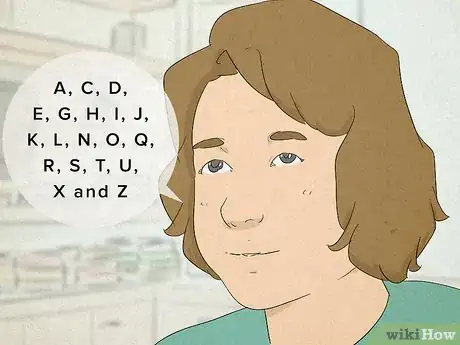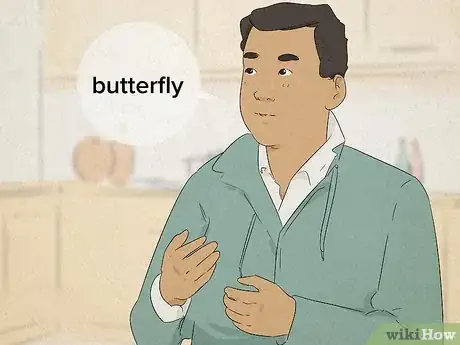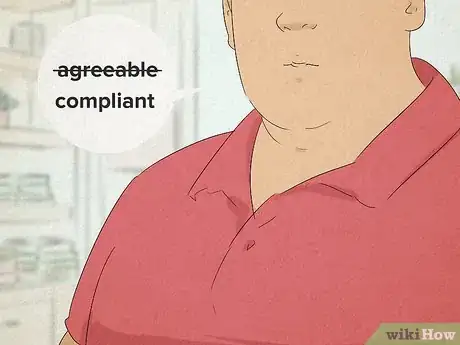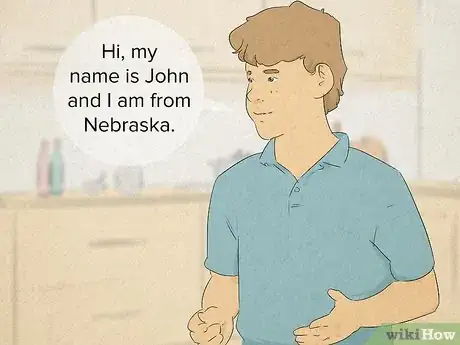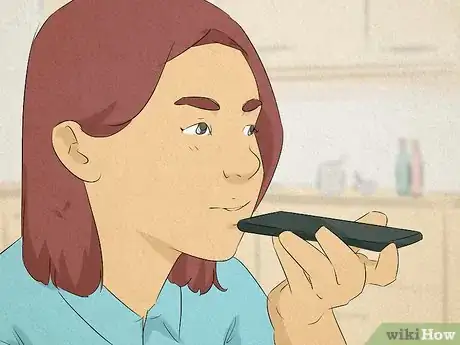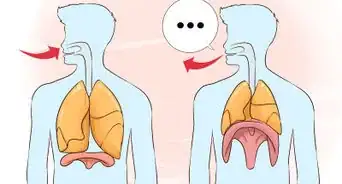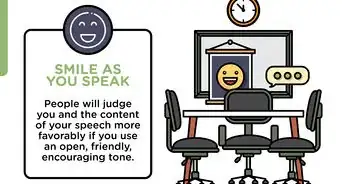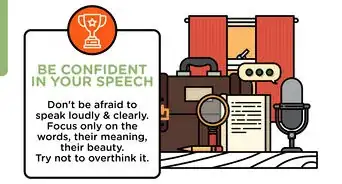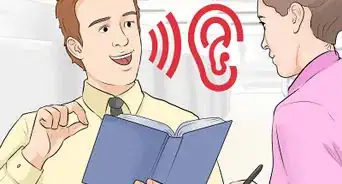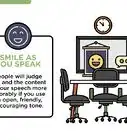This article was co-authored by Amy Chapman, MA. Amy Chapman MA, CCC-SLP is a vocal therapist and singing voice specialist. Amy is a licensed and board certified speech & language pathologist who has dedicated her career to helping professionals improve and optimize their voice. Amy has lectured on voice optimization, speech, vocal health, and voice rehabilitation at universities across California, including UCLA, USC, Chapman University, Cal Poly Pomona, CSUF, CSULA. Amy is trained in Lee Silverman Voice Therapy, Estill, LMRVT, and is a part of the American Speech and Hearing Association.
This article has been viewed 88,739 times.
Talking with your mouth closed can be fun and useful. However, it can also be a little challenging. Thankfully, by learning how to position your mouth properly, mastering basic sounds and the alphabet, and working on complex words, you'll be better able to talk with a closed mouth.
Steps
Positioning Your Mouth
-
1Part your lips. To speak with your mouth closed, you’ll need to make sure your lips are parted ever so slightly.[1] Without parting your lips just a little bit, you won’t be able to get any sound out of your mouth.[2]
- Practice parting your lips in front of a mirror. You should be able to breathe normally and see your teeth ever so slightly.
-
2Touch your teeth together. After parting your lips, you’ll need to make sure your top and bottom front teeth are lightly touching each other. If your teeth aren’t touching, people will be able to see your tongue moving as you talk.[3]
- Don’t grind your teeth against each other. Instead, let them sit together comfortably. Your jaw should be relatively relaxed.
Advertisement -
3Make sure your tongue can move. Once you have your lips and teeth in place, drop your tongue lower in your mouth and try to move it around.[4] If your tongue can’t move enough, you won’t be able to make the sounds you need to make.[5]
- If your tongue can’t move, you may need to relax your jaw a little bit and part your teeth a little bit.
-
4Look at yourself in the mirror. After you’ve positioned your mouth, you need to look at yourself in the mirror. Your lips should be parted a little. You may be able to see your teeth. However, you should not be able to see your tongue.[6]
- If you can see your tongue, or see it moving around, you’ll need to position your teeth so they hide your tongue.[7]
-
5Breathe normally. Inhale through your nose and exhale through your mouth. Make sure to stay calm. Avoid hyperventilating or breathing too deeply. If you breathe too deeply, you won’t be able to keep your mouth closed.
Mastering Sounds, Words, and Sentences
-
1Practice easy letters. Say easy letters repeatedly until you can say them comfortably. Try to articulate with your tongue rather than opening your mouth.[8] Ultimately, the only way to speak with your mouth closed is to practice making as many different sounds as possible. Easy letters include:
- A, C, D, E, G, H, I, J, K, L, N, O, Q, R, S, T, U, X and Z.[9]
- In general, vowel sounds are easier to say with a closed mouth than consonants.
-
2Work on tough letters. There are 7 letters (B, F, M, P, V, W and Y) that are especially tricky to say with your mouth closed. This is because they require you to move your lips to make the sounds associated with them. To make the sounds of these letters, you’ll have to substitute them for easier letters or sounds. Substitute:
- D for B
- “Eth” for F
- N for M
- T for P
- “Thee” for V
- O for I
- W and Y[10]
-
3Try saying some words. After you’ve mastered your letters, try practicing full words. Feel free to start off with easy words like “mom” and move on to tougher words like “butterfly.” Without practicing a variety of words, you won’t be able to master talking with your mouth shut.[11]
- Make a list of easy and difficult words and repeat them 10 to 20 times each – or until you feel comfortable saying them. Then, move on to new words.
-
4Emphasize “ing” when saying a word that starts with a problematic letter. Since “ing” is such a powerful sound, you can use it to obscure your substitution of a difficult letter. Simply emphasize the “ing” and possibly say it louder.
- Since “f” is difficult to say, with “fishing,” say “th-ish-ing.” Say the “ing” loud.[12]
-
5Avoid words that end with “able.” Because of the complex sound and the inclusion of the problematic “b,” you should avoid using words that end in “able.” Instead, substitute different words for words that end with “able.”
- Instead of saying “agreeable,” say “compliant.”
- Instead of saying “adorable,” say “darling.”
- Instead of saying “comfortable,” say “contented.”[13]
-
6Speak entire sentences. Start to put individual words together to form sentences. Make sure to include a few somewhat difficult words. Without these, you won’t be able to master the art of talking with your mouth closed. After enough practice, you’ll find that your pronunciation will get better and better.
- Start with a simple sentence like “Hi, my name is John and I am from Nebraska.”
- Move on to tougher sentences like “I believe that running is one of the most effective ways to exercise.”[14]
Practicing
-
1Write a monologue and practice it. After you’ve mastered the alphabet and words, you should write a monologue and practice it. Start by using words that you’re most comfortable with. However, make sure to incorporate some words that you think are challenging.
- Consider giving a speech with your mouth closed. For example, work on Abraham Lincoln’s “Gettysburg Address.”
-
2Talk to your friends. While practicing by yourself is certainly helpful, you should try talking to your friends with your mouth closed. This way, you can not only entertain them but be challenged by unscripted conversations you’re likely to have with them.
- Try to hold a normal conversation with your friends. Talk about various subjects and let them ask you questions.
- Invite friends and family to watch you talk with your mouth closed.
- Get a ventriloquist dummy or puppet and hone the art of ventriloquism.
-
3Record yourself. One of the best ways to improve your ability to talk with your mouth closed is to record yourself. By recording yourself, you’ll be able to hear exactly how you pronounce certain words. Then, you can practice problematic words until you say them better.[15]
- Use your cellphone or a tape recorder to record yourself.
Community Q&A
-
QuestionCan I teach myself to be a ventriloquist?
 Community AnswerYes, you can! Creativity, passion, enthusiasm and determination are all you need. And of course, you can always seek inspiration from other well-known ventriloquists to improve your skills!
Community AnswerYes, you can! Creativity, passion, enthusiasm and determination are all you need. And of course, you can always seek inspiration from other well-known ventriloquists to improve your skills! -
QuestionWould this help me be a ventriloquist?
 Alex PotatoCommunity AnswerYes, it would help you to become a ventriloquist. Of course, it will still take lots of practice.
Alex PotatoCommunity AnswerYes, it would help you to become a ventriloquist. Of course, it will still take lots of practice. -
QuestionIs it okay to speak difficult letters by using easier letters when talking with my mouth closed?
 Community AnswerYou could try, yes. Many ventriloquism books and courses get into this. It won't be perfect, but you should be able to communicate, still.
Community AnswerYou could try, yes. Many ventriloquism books and courses get into this. It won't be perfect, but you should be able to communicate, still.
References
- ↑ Amy Chapman, MA. Voice & Speech Coach. Expert Interview. 18 October 2019.
- ↑ https://scoutlife.org/hobbies-projects/funstuff/28635/learn-how-to-be-a-ventriloquist/
- ↑ https://scoutlife.org/hobbies-projects/funstuff/28635/learn-how-to-be-a-ventriloquist/
- ↑ Amy Chapman, MA. Voice & Speech Coach. Expert Interview. 18 October 2019.
- ↑ https://scoutlife.org/hobbies-projects/funstuff/28635/learn-how-to-be-a-ventriloquist/
- ↑ http://boyslife.org/hobbies-projects/funstuff/28635/learn-how-to-be-a-ventriloquist/
- ↑ http://boyslife.org/hobbies-projects/funstuff/28635/learn-how-to-be-a-ventriloquist/
- ↑ Amy Chapman, MA. Voice & Speech Coach. Expert Interview. 18 October 2019.
- ↑ http://boyslife.org/hobbies-projects/funstuff/28635/learn-how-to-be-a-ventriloquist/
- ↑ http://boyslife.org/hobbies-projects/funstuff/28635/learn-how-to-be-a-ventriloquist/
- ↑ https://www.brownielocks.com/ventriloquism.html
- ↑ https://www.brownielocks.com/ventriloquism.html
- ↑ https://www.brownielocks.com/ventriloquism.html
- ↑ https://comedyventriloquist.com/how-to-do-ventriloquism-pictures/
- ↑ https://comedyventriloquist.com/how-to-do-ventriloquism-pictures/
About This Article
Talking with your mouth closed takes a little practice, but once you get the hang of it, it's a useful trick. To position your mouth correctly, part your lips slightly, touch your teeth together, and make sure you have room to move your tongue. Practice saying letters at first, then move on to simple words when you’ve mastered those. When you’re just starting out, look in the mirror when you speak to make sure you’re not moving your mouth too much. Try to avoid the letter “f”, and the sounds “ing” and “able,” since these are pretty hard to say with your mouth closed. Once you’ve practiced for a while, try out your new skills in front of your friends to see if they can understand you. To learn how to come up with a monologue to say with your mouth closed, read on!



